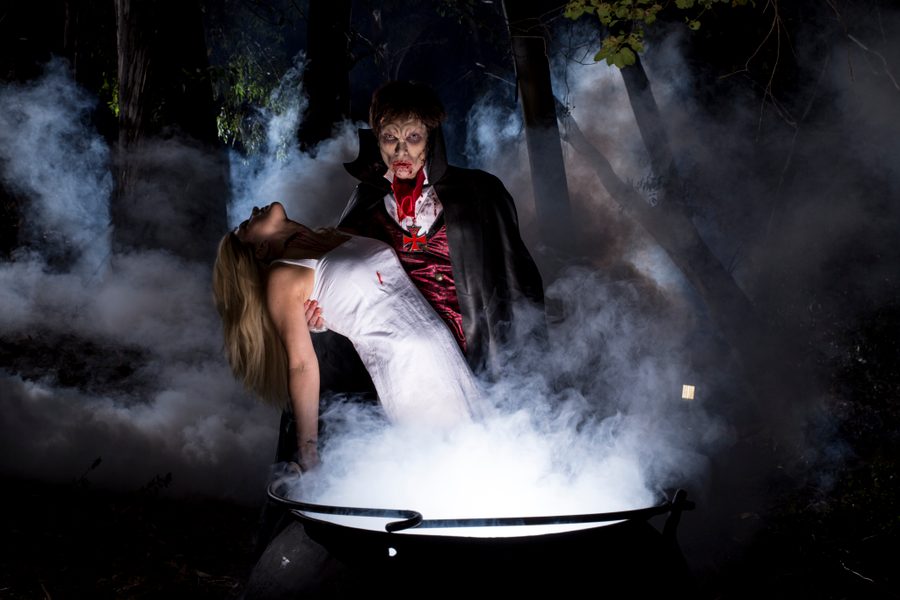Halloween and the Horrors of Capitalism
When have you ever seen a poor vampire?
Natascha Elena Uhlmann

A mother forced to carry something sinister in her womb.
A hopeless, deindustrialized town with a family like yours or mine — except they eat people.
A wealthy count that feasts lavishly on our blood.
What can the horror genre tell us about the world we live in? As it turns out, quite a bit.
Karl Marx’s writings are rife with allusions to things that go bump in the night— from capitalism’s unquenchable, vampiric thirst “for the living blood of labor” to werewolves and ghosts skulking in the dark corners of our political economy. When Marx writes that capital “comes dripping from head to foot, from every pore, with blood and dirt,” it’s hardly an abstraction; he speaks to a system that finds new and novel ways to ravage us day after day. It’s little wonder he found no more apt metaphors than these for a system whose survival rests on cannibalizing us all.
What better way to depict this anxiety than with a home invasion flick, like the 1997 classic Funny Games, which conveys the visceral despair of alienation in a world that has reduced our friends and neighbors to potential threats? Funny Games has come to define the home invasion trope in popular cinema and is perhaps so affecting because of the sheer contempt it holds for its genre. “I don’t like violence. And I don’t like horror movies” said director Michael Haneke in a 2008 interview. “I would say that Funny Games is a self-reflexive anti-horror film. It’s a criticism of violence, because that really makes me angry.”
The film follows Georg and Anna, their son Georgie and pet dog, vacationing at their holiday home. Trouble soon finds them in the way of Peter and Paul, two seemingly upper-crust young men who assail the family with no cause or explanation. What follows is a slow, tormenting dread punctuated by moments of callous violence — a golf club to the knee, a beloved family pet clobbered — and, just as the mayhem crests, Paul’s eyes find ours. With a sly wink, viewers are reminded that the two young men are ultimately here at our behest—is it not the spectacle of violence that brought us to these theater seats? It’s a theme Haneke plays with throughout the film; at a pivotal moment, Paul’s weapon of choice is not a knife or gun but a remote control. “Anyone who leaves the cinema doesn’t need the film”, Haneke famously stated, “and anybody who stays does.”
You’d never know it from the many imitations hell-bent only on replicating the gory excesses from Funny Games. The Strangers, a 2008 psychological thriller starts from the same pastoral fantasy: a perfectly whatever couple have their idyllic vacation home infiltrated by unwelcome, sadistic criminals motivated to kill. But where Haneke takes a deep interest in the inner lives of his characters, The Strangers isn’t much concerned beyond how good they are at screaming. Where Funny Games begs us to stir from the stupor of violent oversaturation, The Strangers is content to let our eyes glaze over with gore. In an era of pro-cop public relations departments and violent crime as entertainment, we should be wary of how these depictions shape the way we move through the world. Playing to every paranoiac right-wing fantasy of crime, The Strangers’ villains can offer no more motive than “because you were home.” Would this film have the same resonance in a world where we speak to our neighbors? What, if not faceless, formless villains, can speak to the slumbering dread of precarity where your landlord and boss decide if you have a place to sleep?
The defining films of the genre today don’t shy away from the moral rot at the heart of capitalism, but make it their plaything: Bong Joon-ho’s genre-defying 2019 film Parasite revels in the class contradictions of a world where rich and poor live unimaginably different realities. The film lulls you into a false sense of security as the Kims, a family struggling in the clutches of poverty, land jobs working for the wealthy Park family. It’s a rare stroke of luck that will change their lives, until that too slips through their grasp. At every turn, we’re reminded how deeply our lives lie at the hands of the wealthy — and the lengths to which we’ll be degraded for it.
The 1977 film Suspiria, too, echoes this suspicion, presented expertly through the art of movement. The film’s protagonist, Suzy, is at first shielded from her dance institute’s more unsavory elements. Early on, she wins the favor of the school’s matron, Madame Blanc; while the other dancers toil endlessly to improve their craft, Suzy, it seems, is destined for better things. As Olga, an idealistic young dancer bends to the supernatural forces of witchcraft, we too are mangled at the altar of production. The omnipotent, towering status of the matrons echoes the crushing forces of capital: when the cost of resistance is so devastatingly high, sometimes it’s easier to just keep dancing.
The terrors of our day resurrect once-buried films of the past. The 1968 cult classic Rosemary’s Baby takes on a new darkness with the fall of Roe: here, the great villain of the film is not Satan himself, but a world that at its very core despises women. The horrors Rosemary endures are hardly unfamiliar to viewers today, when intimate partner violence alone affects more than 12 million people each year and rape by a marital partner is four times more common than by strangers. As Rosemary begins to suspect that things are not as they should be, she is minimized at every turn; not just by her deadbeat husband but her doctors, neighbors and the world at large. Jordan Peele, the horror icon of our generation, pointed to the film’s influence on his own work, stating: “I set myself the goal of doing a thriller in the mold of Rosemary’s Baby… something with an overarching satirical commentary.” Get Out, Peele’s resultant 2017 work, tugs at the deep-rooted rot at the heart of polite society with equal parts humor and fear. Here again, the great horror lies not just in monsters or boogeymen, but a world that seeks to possess and destroy its protagonist: over the course of the film, the protagonist, Chris, discovers that his weekend trip to meet his girlfriend’s parents was a ploy to transplant someone else’s brain into his body. By the end of the film, Chris escapes to safety with the help of a friend.
Though happy endings can feel elusive in horror, stories like Get Out, in which the protagonists survive, provide us with hope that sometimes, against all odds and under a system of brutal exploitation, the monsters can still lose.
Natascha Elena Uhlmann is a staff writer at Labor Notes.








